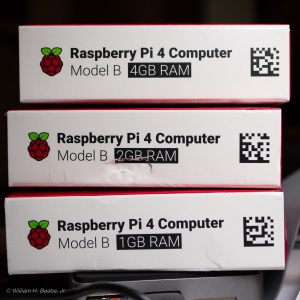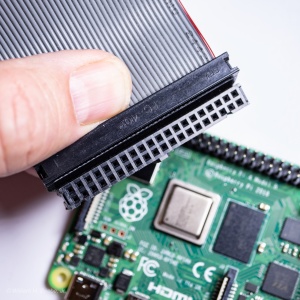
I received my third, and possibly final, Raspberry Pi 4B. The only difference between this copy and the first two is the amount of memory it ships with; it came with 4GB of RAM. The other two were outfitted with 1GB and 2GB respectively. I’ve spent the majority of my time so far working with the 2GB variant, waiting for the 4GB version to arrive. It finally arrived this past Saturday in the mail.
The latest Raspberry Pi 4B came all the way from somewhere in the woolly wilds of Canada from an outfit called Canakit (https://www.canakit.com/). It arrived over two weeks after I placed my order, which was the longest two weeks I’ve ever had to wait on just about anything. Canakit does not provide any kind of tracking information, with a stated delivery time of between “6 to 10 business days”. That doesn’t include the three days I waited between the time I first placed my order until they sent me an email it had finally shipped. Towards the end of my wait I was beginning to wonder if I’d made a mistake ordering it from Canakit, that somehow it’d gotten lost in the woolly wilds of Canada (probably due to being stolen by a Sasquatch), and perhaps I should order another from somewhere else. Except at the time there is no somewhere else to order the 4GB version from; everybody has had the 4GB version out of stock or on backorder from the moment it was first announced.
It finally arrived in my mailbox via the US Post Office, packaged in a lovely bright canary yellow and sky blue box. It was reasonably packed in styrofoam popcorn, but not too tightly; it rattled when I shook it. I put the Raspberry Pi 4 into another Flirc case, moved the boot SDXC card from the 2GB Raspberry Pi 4B to the new 4GB system, reconnected all the cabling, and powered it up. From there I ran through all my so-called tests, opening up Chromium with even more tabs, and then let it simmer overnight.
Before I closed up the Flirc case, I took the 40-pin flat cable and a file and filed down the outer connector ends of the cable end that connects to the Raspberry Pi’s male 40-pin GPIO connector. This allowed me to then physically place the attached cable with Pi inside the Flirc case. With everything buttoned up I was able to connect to my external hardware I’ve been working with and to check it all out. Worked like a charm.
Overall the 4GB version is behaving just like the 2GB version with one very important exception. The 4GB version is not swapping to disk, or should I say, the SDXC card at all. Even when I had two browsers up (Chromium and FireFox) as well as all my Julia code and playing a video (Blender’s “Tears of Steel”) I had no need to swap to memory. The temperature fluctuated between 45C and 55C, sticking around 50C while I was working.
Writing about FireFox, I was somewhat surprised that the current FireFox available through the current Raspbian Buster repo consumes about twice as much memory than Chromium, and that’s with far fewer FireFox tabs open compared to how I run Chromium. I will keep FireFox installed in order to be able to test with it, but for day-to-day usage it’s going to be Chromium.
I’ve come to truly appreciate the Flirc case. My only complaint has to do with being able to connect cables and then get them out of the enclosure in a clean fashion, but I’ve managed to fix the 40-pin GPIO cabling, and I don’t use the video connectors in my work, so there’s that. The Flirc case is both beautiful and highly practical, keeping the Raspberry Pi processor temperature rock steady around 50C. The only problem with the case, and it’s due to the Raspberry Pi 4 itself, is that using the video connector as well as using any of the hats is problematic due to the excess temperature generated by the CPU. If you want to use a HAT I highly recommend you use the Raspberry Pi 3B or 3B+, DON’T use the Raspberry Pi 4B.
For general computer use, the Raspberry Pi 4B with 4GB of memory is a decent personal computer, especially in a STEM educational or general experimental environment. To build out a useful Raspberry Pi computer system using the 4B, you’re going to need a keyboard, mouse, monitor, power supply, microSDXC card with sufficient storage and a high-quality micro HDSC to regular HDSC cable at a minimum. Adding up the costs; keyboard + mouse is $50, monitor is $100, Flirc case is $15, power supply is $15, Raspberry Pi 4B 4GB is $55, a good SDXC card (say 64GB or more) is now $15, and that decent micro HDMI cable is $25. That’s a rough total of $275. That might be shocking considering the cost of just the Raspberry Pi, but again, the Raspberry Pi 4B 4GB system has two powerful features in its favor:
- Everything is highly modular (USB, WiFi, BlueTooth) and can be swapped around at will, and
- The Raspberry Pi 4B (or any Raspberry Pi for that matter) is wide open to integration into just about any digital project you can conceive of.
You can indeed spend less on a “regular” laptop, such as a low-cost Chrome book, but you have nothing but just a Chromebook that can’t be opened up and experimented with the way the Raspberry Pi can. And keep in mind that my costs are what I was willing to pay. If you have existing equipment or can get the basics for a lower cost, then by all means do so. Consider my prices a ROM and go from there.
Consider these points when building out your system:
- Always buy the recommended power supply for the Raspberry Pi 4B. It has the right voltage (5V), the right current capacity (4A), and the correct connector (USB C). Good, solid power is vital to the proper functioning of the computer and anything else you might want to attach to the Raspberry Pi 4B. You do not want to have to chase intermittent problems because the power supply is inadequate. Don’t buy one of those micro USB to USB-C adapters. Spend the little bit extra for a fully qualified power supply.
- Use a decent quality SDXC card with plenty of storage space. Do not accept those 16GB Noobs cards on order today. Go with a minimum of 32GB. Right now, with all the software I have installed on my system, I have at least 13GB just on the root file system. It doesn’t sound like a lot, but it slowly builds up as you add one tool after another. And that’s just the static storage… You won’t save any money and you’ll waste too much precious time trying to use any card smaller than 32GB. I personally use SanDisk Extreme PLUS UHS-1 128GB microSDXC cards. They are guaranteed 90MB/s write and 170MB/s read. I get them at my local Costco for $30 for two, hence the $15 cost per card. Remember when Apple sold low-end iPhones with just 16GB? All that pain trying to not totally fill the iPhone. The same thing has come to the Raspberry Pi world, and the sellers of Pi boot software need to realize it’s time to move up.
- Buy a solid quality micro HDMI to HDMI cable. I spent $16 at a local Walmart on a micro HDMI to female HDMI converter, trying to save a few bucks reusing my existing HDMI cabling. It didn’t work. I ended up purchasing a 1.5 Meter Sony DLCHEU15 Micro HDMI Cable. That $16 was a waste. The Sony works like a charm. Just like with power, don’t purchase an adapter. Buy the complete cable from a reputable maker and avoid the headaches trying to figure out why it doesn’t work.
- Get a solid case. DO NOT purchase the official Raspberry Pi 4 case. It’s plastic, has no ventilation, and will build up heat on the 4B until it throttles itself. I personally recommend the Flirc, but I’m sure there are others out there. In addition, steer clear of the cute little colored heat sinks that fit on top of the processor and memory. I thought they worked, until I discovered via the 4B they didn’t at all. There may be some that actually work, but I don’t know who they are. Outside of Flirc, I don’t know who to recommend either.


I can personally recommend the Zebra 4 case from C4 Labs. It includes a fan which can be connected to either 5V or 3.3V pins on the GPIO. It does what it should, keeping the CPU cool.
LikeLike
Thank you. I looked it up and found it here: https://www.c4labs.com/product/zebra-4-interior-fan-case-raspberry-pi-4/
On the page they do state “No GPIO access”, so there is that to consider.
LikeLike